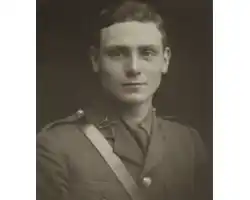24 June 2019
|
While researching her family tree Jill Bush uncovered the story of a teenage First World War pilot with a unique place in history. Now she is finally revealing her ‘little-known warrior’s’ heroism to the world.
While researching her family tree Jill Bush uncovered the story of a young First World War pilot with a unique place in history. Now she is finally revealing her ‘little-known warrior’s’ heroism to the world
Family history is like a perennial weed – you can pull the top off, but the roots remain, pervasive and twisting, ready to spring into life again given the slightest encouragement.
Lionel Morris was my grandfather’s first cousin, and the first pilot to be shot down by Manfred von Richthofen, the Red Baron of folk memory, in the Great War. I’ve spent the last six years digging for his story, starting off on my sofa with a laptop and graduating to The National Archives, the RAF Museum and the fields of Artois in Northern France, where rusty relics of the Royal Flying Corps are still grubbed up like those weeds and lovingly preserved by local history enthusiasts.
‘My dad's memories of his great Aunt Lil whose only son might (or might not) have been a victim of Manfred von Richthofen hadn't really registered on my research radar’
I’d always dabbled in family history, but I’d been more interested in looking for romantic Scots ancestors. My dad’s memories of his great Aunt Lil whose only son might (or might not) have been a victim of Manfred von Richthofen hadn’t really registered on my research radar.
Gradually I became more curious and I found Lionel Morris, in high resolution and looking every inch the 19-year-old he was, on a sparsely-worded web page. It’s an itch I haven’t stopped scratching since.
Lionel joins the Royal Flying Corps
Morris was a middle-class public-school Croydon teenager who joined the Army in May 1915, days after the sinking of the Lusitania appalled the world and eventually brought the USA into World War I. A couple of months of square bashing in Kent convinced him there were more exciting ways to serve King and Country and he applied for a transfer to the Royal Flying Corps. He arrived at Mousehold Heath in Norwich; a lowly Second Lieutenant with little but an interest in motor mechanics and limited proficiency in French and German.
Learning to fly in the autumn of 1915 brought Morris into a small but remarkable milieu of men, including Albert Ball, the greatest British ace of the war – not in numbers, but in the benchmark his bravery set. RAF pilots in the Second World War were still in thrall to his legend: ‘He must fall/Remember Ball’.
Whilst Ball went off the Central Flying School in Wiltshire to hone his skills, Morris left for London. His posting to No.19 Reserve Squadron threw him into the thick of the RFC’s Zeppelin nightmare, as they struggled against airships in machines that weren’t fast enough to catch them; equipped with weapons that couldn’t bring them down.
In the late spring of 1916, in the Northern sector of the Western Front near Arras, Ball wrote home to tell his parents that his unit, No.11 Squadron, had lost another man in battle. Second Lieutenant Morden Maxwell Mowat had fallen foul of the German ace Max Immelman. Two days later Morris arrived at Savy Aerodrome as No.11’s commander filled Mowat’s empty chair.
No.11’s beat included territory soon to be pulled into an attack on Gommecourt: an attempt to distract the enemy from the Fourth Army’s main show on the Somme. This crack squadron, arguably the first fighter unit in the world, was led by Major Thomas O’Brien Hubbard, a pre-war flier whose gentle nature earned him the nickname ‘Mother’ Hubbard.
From May to September Lionel Morris turned himself into a fighter pilot. In his first week with No.11 he’d struggled to clear the trees on take-off. Barely six weeks later, on 1 July, the first day of the Battle of the Somme, he and his observer Glover saw off 11 Germans on a dawn patrol.
Luck was on his side: the RFC were so dominant at that stage of the war that few enemy aircraft dared challenge the squadrons who were bursting over the lines with the chutzpah and confidence that came of an offensive imperative. How could any air force defend such a vast sky when a tried and tested French strategy of pestering the Germans in their own back yard had been so successful at Verdun?
That Morris survived those lethal first few weeks of battle showed his nerve and mettle. On 22 August he and his observer Tom Rees had their first shared victory in a multi-aircraft dogfight that reeled over the Butte de Warlencourt in the struggle for Bapaume. On 14 September, just before the second phase of the Somme brought the tank into modern warfare, they brought down another.
But the enemy were regrouping and reorganising. Oswald Boelcke, the supreme tactician of the German air force, marshalled a squadron of hand-picked pilots including Manfred von Richthofen, and drilled into them his own time-served experience.
On 17 September, 1916, as No.11 escorted a bombing raid over the town of Marcoing, Boelcke’s boys struck for the first time.
Shot down
Richthofen singled out Morris and Rees in their green FE2b: despite their resourcefulness and persistence, the German’s faster machine and superior training defeated them. Rees was killed in the air; Morris managed to land the plane despite gunshot wounds to three of his limbs, dying later as Richthofen pulled a souvenir manufacturer’s plaque off the plane that had, like Morris himself, travelled from Mousehold Heath to the Western Front. The ground crew of No.11 waited in vain at Savy as four FE2bs failed to return from Marcoing.
Other stories that might interest you:
• Write your family history in 1,000 words!
• How family history inspired my writing: from the River Kwai to the Thames
• The smallest things – a family history journey
RFC Commander Trenchard, already formulating a policy document that would influence the air force through to the next war, realised that the loss of such an able flight of men was a dangerous turning point. His call for a single-minded commitment to offensive flying went to the very top of the British Army. Richthofen went on to make 80 kills before he himself was shot down in April 1918.
Decades passed, and Lionel Morris disappeared into his own family history while the legend of the Red Baron grew. Then, in 2016, an exhibition at Whitgift School in Croydon highlighted the role that Morris had played in Richthofen’s beginnings, using the research I had begun three years before. Over 25,000 people attended, and I was struck how they were responding to this conjunction of family tragedy with world events. I became convinced that Morris’s story deserved an extended narrative.
Two shared victories didn’t make an ace and Morris didn’t live long enough to be rewarded with any honours; even a recommendation for a Mention in Despatches was vetoed. But as George Eliot once wrote: ‘The growing good of the world is partly dependent on unhistorical acts; and that things are not so ill with you and me as they might have been, is half owing to the number who lived faithfully a hidden life, and rest in unvisited tombs.‘
• Lionel Morris and the Red Baron is published on 30 June 2019 by Pen and Sword Books.
Images: 2nd Second Lieutenant Lionel Bertram Morris in his Queens Royal West Surrey Regiment in 1915 courtesy of Phil Evans, Whitgift School; Manfred von Richthofen courtesy of Greg Van Wyngarden, James F. Miller; author photo © Jill Bush; book cover © Pen & Sword.











.jpg)
